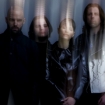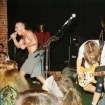In the early Eighties, young denim-and-leather-clad headbangers in bands like Metallica, Slayer, and Anthrax exploded onto the scene with a new form of heavy music: thrash, which combined NWOBHM-inspired virtuosity with punk-rock attitude. This breakneck brand of metal has gone on to influence everyone from Lamb of God to Trivium and Killswitch Engage. To get you up to speed, we've assembled a loud library of 25 classics. Brace yourself for a nasty case of whiplash.
Anthrax - Among the Living
(Island, 1987)
Besides helping to put the word "mosh" into the pop lexicon ("Caught in a Mosh") and featuring the best metal song about Native Americans since Maiden's "Run to the Hills" ("Indians"), Among the Living showcased Charlie Benante's insane speed drumming and Scott Ian and Dan Spitz's hardcore-inflected guitar work, which together made for a total beatdown, NYC-style.
Carnivore - Carnivore
(Roadrunner, 1986)
Pete Steele's pre–Type O Negative band Carnivore crossed bleak doom with hardcore to create a knowingly knuckle-dragging form of thrash. Raw, cynical, almost avant-garde, this album is, however, best remembered for its misanthropic though wryly humorous lyrics on songs like "God Is Dead" and "World War III & IV."
Dark Angel - Darkness Descends
(Combat, 1986)
Before doing time in Death, Testament, Strapping Young Lad and Dethklok, drummer Gene Hoglan made this album roar, holding together the lesser performances of bandmates interested only in out-heavying Slayer. While it doesn't quite achieve that goal, Darkness Descends does deliver a vicious, messy attack that lives up to Dark Angel's motto: "Too fast my ass."
Death Angel - Frolic Through the Park
(Restless, 1988)
Filipino-American thrashers Death Angel often went over people's heads, creating a loose, overdriven, push-pull sound that definitely hadn't been anywhere near a click track. Further confounding, vocalist Mark Osegueda could be downright soulful over structures that at times tread dangerously near to funkiness. Still, there's no question that on Frolic, the band's chemistry was magical.
Destruction - Eternal Devastation
(SPV/Steamhammer, 1986)
Weil am Rhein, Germany's Destruction evolved from their first-wave-of-black-metal roots into full-fledged Teutonic thrash titans on album No. 2. The title says it all: Eternal Devastation is fast, messy and aimed at destruction, with vocalist Schmier channeling Bathory's Quorthon and guitarist Mike Sifringer soloing in the psycho-killer vein of Slayer.
Exodus - Bonded by Blood
(Combat, 1985)
Metallica got the glory (and Exodus guitarist Kirk Hammett), but this Bay Area institution was actually the first to take thrash from punky primitivism to virtuosic technicality, plying its trade for a good three years before Bonded by Blood cemented the band's status. And 17 years before singer Paul Baloff tragically died after a stroke. (R.I.P.)
Flotsam and Jetsam - Doomsday for the Receiver
(Metal Blade, 1987)
Flotsam would soon cough up bassist (and main songwriter) Jason Newsted to Metallica, but not before creating this spectacularly dense and intense collection of speed-metal anthems. A big Priest and Maiden influence is obvious, but whereas those NWOBHM deities left their listeners room to breathe, Flotsam fill every crevasse with relentless shred.
Forbidden - Forbidden Evil
(Metal Blade, 1988)
Boasting three songs co-written by current Machine Head main man Robb Flynn (though he had left the band by the time the album was recorded) and stellar drumming by future Slayer skinsman Paul Bostaph, Forbidden Evil is smart, virtuosic thrash with a power-metal streak, due in large part to frontman Russ Anderson's piercing falsetto.
Kreator - Pleasure to Kill
(Noise, 1986)
Released the same year as Master of Puppets, Reign in Blood, Peace Sells..., Eternal Devastation and Darkness Descends, Kreator's second album had to be razor-sharp to cut through the noise. Fortunately, Mille Petrozza and Co. were up for the challenge. As a result, this ripper has popped up everywhere from Cannibal Corpse's list of influences to the soundtrack of Netflix series Dark.
Metal Church - The Dark
(Elektra, 1986)
The Dark might have too much classic-metal influence on it to be described as a straight up thrasher, but singer David Wayne (R.I.P.) and crew could tear it up when they wanted to: Check out crusher "Ton of Bricks," one good reason this beloved Seattle outfit more than held their own as part of Metallica's legendary Master of Puppets tour.
Metallica - Master of Puppets
(Elektra, 1986)
1984's Ride the Lightning established Metallica as the thrash act with not only the most personality but the most skill and ambition. Its follow-up took James, Lars, Kirk, and Cliff's newly epic palette into cinemascope — and did so with such mastery that Master consistently polls as the greatest metal album of all time, thrash or otherwise.
Megadeth - Peace Sells… But Who's Buying?
(Capitol, 1986)
Major-label deal in hand, a chip on his shoulder, and an excellent though short-lived lineup (guitarist Chris Poland, bassist David Ellefson, and drummer Gar Samuelson) backing him up, ex-Metallica guitarist Dave Mustaine channeled personal bitterness and pointed politics through his signature snarl and superior shredding skill, creating this masterpiece of thinking man's thrash.
Nuclear Assault - Survive
(MCA, 1988)
Post-Anthrax and S.O.D., bassist Danny Lilker brought his low-end chops to this harsh, political East Coast thrash act. The S.O.D. influence is apparent in the occasional silly bits (such as the tongue-in-cheek Led Zeppelin cover, "Good Times, Bad Times"), but most notable is Randy Burns' wall-of-sound production and the band's balance of technicality and primal power.
Overkill - The Years of Decay
(Megaforce, 1989)
Album No. 4 for these New Jersey tech-thrash stalwarts was the last to feature guitarist Bobby Gustafson, whose thick, doomy riffs on epics like the 10-minute "Playing With Spiders/Skullkrusher" helped lend Overkill a somber earthiness less evident in the band's West Coast competitors. No doubt having famed producer Terry Date (Pantera, Deftones) manning the board didn't hurt either.
Possessed - Seven Churches
(Century Media, 1985)
Disciples of proto–black metallists Venom and Bathory, San Francisco's Possessed shrouded their blasphemous imagery in lo-fi production values. Pure, chaotic speed was key, yet the playing of guitarist Larry Lalonde was experimental and adventurous enough to eventually land him a spot in prog-funksters Primus.
Sacred Reich - Ignorance
(Metal Blade, 1987)
On their debut album, Phoenix-based speedsters Sacred Reich tackled topics of political and social injustice like many a good thrash band did, turning singer Phil Rind's outraged diatribes into perfect slam-dance fodder. The band would go on to become unwitting pioneers of metalcore, particularly influencing the more 'core acts of that scene, such as Hatebreed.
Sanctuary - Refuge Denied
(Epic, 1987)
Perhaps best known as singer Warrel Dane and bassist Jim Sheppard's pre-Nevermore band, Seattleites Sanctuary deserve attention in their own right, mostly for their fist-pumping debut album, which was produced by none other than Dave Mustaine and displays jaw-droppingly high-pitched, layered vocals that Dane has yet to match.
Sepultura - Arise
(Roadrunner, 1991)
Brazil's finest have evolved through many sounds — death metal, groove metal, nu-metal — but they never thrashed harder than on Arise. From the title track to "Dead Embryonic Cells" to "Desperate Cry," Sepultura's fourth full-length salvo shocks and awes — while also hinting at new elements, like industrial, punk and Latin percussion, making their way into the group's sound.
Slayer - Reign in Blood
(American, 1986)
Slayer were the new face of speed metal, and yet they were so confrontationally evil that they could have easily been considered death and black metal, too. Confounding genre tags in 28 minutes of howling fury, Reign in Blood proves them to be simply great.
Sodom - Agent Orange
(SPV/Steamhammer, 1989)
Named after the tactical herbicide that the U.S. military infamously used during the Vietnam war, Sodom's third album dives deep into frontman Tim Angelripper's fascination with the conflict. As such, it's a brutal, bestial affair, but one with its heart in the right place: Indeed, the liner notes include a dedication "to all people — soldiers and civilians — who died by senseless aggressions of wars all over the world."
Stormtroopers of Death - Speak English or Die
(Megaforce, 1985)
This Anthrax side project — known commonly by its acronym, S.O.D. — ended up as a left-field underground hit (selling more than a million copies worldwide by 1999), likely due to its novel fusion of metal and hardcore, with Scott Ian providing the hard-nosed riffs and troublemaker Billy Milano spouting the provocative lyrics on 21 ruthlessly short, relentlessly amusing songs.
Suicidal Tendencies - How Will I Laugh Tomorrow When I Can't Even Smile Today
(Epic, 1988)
How Will I Laugh found the motor-mouthed Mike Muir and his Suicidals sprucing up their gang-banged skatecore rants with semi-complicated riffs, solos, and longer song structures. The result was crossover thrash with a fresh, gritty sound that clearly came from a hardcore, not a metal, headspace.
Testament - The New Order
(Megaforce, 1988)
The thrash anthem "Into the Pit" dominates Testament's mosh-ready sophomore disc, with the San Fran quintet positioning themselves as purists, carrying on the work of Metallica and Exodus. The inventive playing of uber-shredder Alex Skolnick, however, makes the band not just defenders of the faith but true proponents of a new order.
Vio-lence - Eternal Nightmare
(Mechanic, 1988)
After leaving Forbidden, Robb Flynn met his future–Machine Head bandmate guitarist Phil Demmel in this Bay Area five-piece. Together they cranked out tight, traditionalist thrash on the band's second full-length, which is rife with crazy chops, novel progressive arrangements, and, of course, plenty of violence ("Serial Killer," "Calling in the Coroner").
Voivod - Dimension Hatröss
(Noise, 1988)
Hailed by the likes of Dave Grohl, Meshuggah and Jason Newsted (who played bass in the band in the 2000s), Canadian weirdos Voivod represent the proggy, trippier end of the thrash spectrum. Dimension Hatröss — a sci-fi concept album recounting the exploits of the band's mascot cyborg Korgull — captures them mid-transformation from their speed-metal early days into something more singular and compelling.












